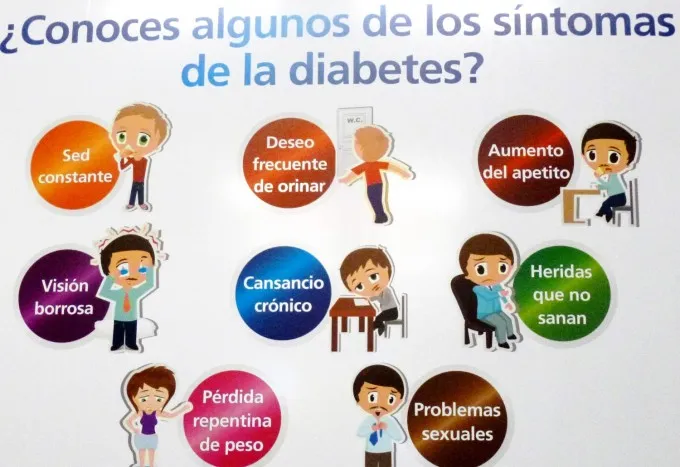Diabetes is a chronic (for life) disease in which there are high sugar levels (blood glucose).
Causes
Type 1 diabetes can occur at any age, but it is more frequently diagnosed in children, adolescents or young adults.
Insulin is a hormone produced by special cells, called beta, in the pancreas, an organ located in the area behind the stomach.Insulin is needed to mobilize blood sugar (glucose) to cells, where it is stored and then used to obtain energy.In type 1 diabetes, these cells produce little or no insulin.
Without sufficient insulin, glucose accumulates in the bloodstream instead of entering the cells and the body is unable to use it to obtain energy.This leads to the symptoms of type 1 diabetes.
The exact cause of this type of diabetes is unknown, but the most likely is an autoimmune disorder.An infection or some other trigger causes the body to attack by error the insulin producing cells of the pancreas.This type of disorder can be transmitted from parents to children.
Symptoms
These symptoms can be the first signs of type 1 diabetes or can occur when blood sugar is high:
- Be very thirsty
- Feeling hungry
- Feeling tired or tired
- Have blurred vision
- Lose sensitivity or feel tingling on the feet
- Lose weight without proposing it
- Us more frequently
For other people, these warning symptoms can be the first signs of type 1 diabetes, or they can occur when blood glucose is very high (see diabetic ketoacidosis):
- Deep and fast breathing
- Mouth and dry skin
- Red face
- Breath with the smell of fruit
- Nausea or vomiting, inability to retain fluids
- Stomachache
Low blood glucose (hypoglycemia) can occur rapidly in people with diabetes who are taking insulin.Symptoms typically appear when the blood glucose level falls below 70 mg/dl.Be careful with:
- Headache
- Hunger
- Nervousness
- Fast heartbeat (palpitations)
- Tremors
- Sweating
- Weakness
tests and exams
Diabetes is diagnosed with the following blood tests:
- fasting glycemia level: Diabetes is diagnosed if it is greater than 126 mg/dl twice.
- Random blood glucose level (without fasting): you can have diabetes if it is greater than 200 mg/dl and has symptoms as an increase in thirst, urination and fatigue (this should be confirmed with an empty stood).
- Oral glucose tolerance test: Diabetes is diagnosed if the glucose level is greater than 200 mg/dl after two hours.
- A1C hemoglobin exam:
- Normal: less than 5.7%
- Prediabetes: between 5.7% and 6.4%
- Diabetes: 6.5% or higher
Sometimes, the ketone exam is also used.The ketone exam is done using a sample of urine or a blood sample and can be done:
- When blood glucose is greater than 240 mg/dl.
- During a disease such as pneumonia, heart attack or stroke.
- When nausea or vomiting occur.
- During pregnancy.
The following exams will help you and your doctor watch your diabetes and prevent problems caused by this disease:
- Inspect the skin and bones on the feet and legs.
- Verify if the feet are presenting numbness.
- Make the blood pressure review at least every year (the ideal blood pressure should be 130/80 mm/hg or lower).
- Take an A1C (HBA1C) hemoglobin exam every 6 months if your diabetes is well controlled;Otherwise, every 3 months.
- Make check the levels of cholesterol and triglycerides annually (try to achievecholesterol levels below 70-100 mg/dl).
- Take annual exams to verify that the kidneys are working well (microalbuminuria and creatinine in serum).
- Visit the ophthalmologist at least once a year or more frequently if you have signs of diabetic retinopathy.
- Visit the dentist every 6 months for full cleaning and dental examination, making sure that the dentist and hygienist know that you suffer from diabetes.
Treatment
Because type 1 diabetes can start quickly and symptoms can be serious, people who have just been diagnosed may need to remain in the hospital.
If you have just given the diagnosis of type 1 diabetes, a medical checking should probably be done every week until you have good control over your blood sugar.The doctor will review the results of the monitoring of their glycemia at home and urine tests.The doctor will also examine his food, refreshments and insulin injections.
As the disease becomes more stable, you will need less control visits.Visiting the doctor is very important for you to monitor any long -term problem following diabetes.
You are the most important person to handle diabetes and you should know the basic steps for the management of this disease:
- How to recognize and treat the low level of blood sugar (hypoglycemia)
- How to recognize and treat the high level of blood sugar (hyperglycemia)
- Diabetic meal planning
- How to administer insulin
- How to control blood glucose and ketones in urine
- How to adjust insulin and food consumption during exercise
- How to handle the days you are sick
- Where to buy the supplies for diabetics and how to store them
Insulin
Insulin lowers the blood sugar level allowing the bloodstream to be out of the cells.Every person with type 1 diabetes should take insulin daily.
Insulin is generally injected under the skin.In some cases, a bomb releases insulin continuously.Insulin does not come in the form of pills.
Insulin types differ by the speed with which they begin to take effect and their duration.The doctor will select the best type of insulin for you and tell you what time of day you should use it.You can mix more than one type of insulin in the same injection in order to achieve the best blood sugar control.You may need insulin injections one to four times a day.
The GP or an expert in diabetes will teach you how to inject insulin.Initially, injection into children must be applied by one of the parents or another adult.By the age of 14, most children can apply their own injections.
People with diabetes need to know how to adjust the amount of insulin they are taking in the following situations:
- When exercising
- When they are sick
- When they are eating more or less food and calories
- When they are traveling
Diet and exercise
People with type 1 diabetes should eat approximately at the same time every day and try to eat the same types of food.This helps prevent your blood sugar from becoming too high or low.See also:
- Diabetes diet
- Take snacks when you have diabetes
The American Association for Diabetes (American Diabetes Association) and the American Dietary Association (American Dietetic Association) offer information on the planning of a healthy and balanced diet.Likewise, you can help consult with a professional dietitist or a nutritionist.
ExerciseRegular helps control the amount of blood sugar, as well as burn excess calories and fat to achieve healthy weight.
Ask the doctor before starting any exercise program.Those with type 1 diabetes must take special precautions before, during and after any intense exercise or physical activity.See also: diabetes and exercise.
Management of your blood sugar
Check the blood sugar levels at home and write down the results will indicate how well you are handling your diabetes.Talk to the doctor and the diabetologist regarding both how much the check must be done.
A device called glucometer can read blood sugar levels.There are different types of devices.Normally, you puncture your finger with a small needle called Lanceta to get a tiny blood drop.The blood is placed in a reactive strip and put the strip on the device.The results must be in a matter of 30 to 45 seconds.
Keep a record of your blood sugar for you and your doctor or nurse.This will serve if you have problems handling your diabetes.You and your doctor should set a goal to achieve for your blood sugar levels at different times during the day.You must also plan what to do when your blood sugar is too low or tall.
For more information, see the article: management of your glycemia.
Low blood sugar is called hypoglycemia.Blood sugar levels below 70 mg/dl are too low and can harm it.
Feet care
Diabetes causes damage to blood vessels and nerves, which can lead to less ability to feel pressure on your feet.It is possible that you do not notice a foot injury until a severe infection develops.
Diabetes can also cause damage to blood vessels.Small sores or skin openings can become deeper sores or ulcers.Likewise, the amputation of the affected member may be necessary if these skin ulcers do not heal or become larger or deeper.
To prevent feet problems:
Stop smoking if it's smoker.
Improve your blood sugar.
Let your feet examine at least twice a year by a doctor and know if you have neurological damage.
Review and take care of your feet every day, especially if you already know that damage to nerves or blood vessels or current problems on your feet has been presented.
Verify that you are using the correct type of shoes.
Prevent complications
The doctor can prescribe medications or other treatments to reduce their chances of developing eye disease, kidney disease and other conditions that are more common in people with diabetes.
See also:
Heart attack prevention and stroke by diabetes
Long -term diabetes complications
prognosis
Diabetes is a life disease for which there is still no cure;However, the forecast for the people who suffer from it varies.
Studies show that strict blood sugar control can prevent or delay eye problems, kidneys, nervous system and heart in type 1 diabetes. However, problems can even occur even in those people with aGood disease control.
possible complications
If you have diabetes, your risk of a heart attack is equal to that of someone who has already had one.Both women and men with diabetes are at risk.You may not even have the normal signs of a heart attack.
After many years, diabetes can lead to other serious problems:
- You couldHave eye problems, such as difficulty seeing (especially at night) and light sensitivity.- - - You could be blind.
- Your feet and skin can develop ulcers and infections.If you have these ulcers for a long time, your foot or your leg may need amputation.The infection can also cause pain and itching.
- Diabetes can make control of blood pressure and cholesterol.This can lead to a heart attack, stroke and other problems.It may be difficult for blood to circulate to your legs and feet.
- The nerves in your body may suffer damage, causing pain, itching and loss of sensitivity.
- Due to the damage to the nerves, you could have problems digesting the food you eat and could feel weak or have trouble going to the bathroom.Nerve damage can also hinder erection in men.
- High blood sugar and other problems can lead to kidney damage.Their kidneys might not work as well as they used to do it and can even stop working.
See also: Diabetic ketoacidosis.
When to contact a medical professional
Call the local emergency number (such as 911 in the United States) if you have:
- Chest pressure or pain, breathing difficulty or other signs of angina
- Loss of knowledge
- Seizures
- Go to the emergency department or call the doctor if you have symptoms of diabetic ketoacidosis.
Also call the doctor if you present:
- Blood sugar levels that are exceeding the goals that you and your doctor have set.
- Numbness, tingling, pain in feet or legs.
- View problems.
- Ulcers or feet infections.
- Symptoms that your blood glucose is going too down (feeling weak or tired, tremors, sweating, feeling irritable, having problems clearly thinking, fast heartbeat, double or blurred vision, feeling of uneasiness).
- Symptoms of hyperglycemia (being very thirsty, having blurred vision, having dry skin, feeling weak or tired, need to urinate a lot).
- Have blood glucose readings below 70 mg/dl
- You can treat the initial signs of hypoglycemia at home, consuming sugar or sweets or taking glucose tablets.If their hypoglycemia signs do not relieve this or if the blood glucose levels are maintained below 60 mg/dl, go to the emergency room.
Prevention
There is no way to prevent type 1 diabetes and there is no detection test for this type of diabetes in asymptomatic people.
Keep all your vaccines up to date and apply the flu vaccine every year in autumn.
alternative names
Insulin-dependent diabetes;Youth diabetes;Type 1 diabetes
References
Alemzadeh R, Ali O. Diabetes mellitus.In: Kliegman RM, ed.Kliegman: Nelson Textbook of Pediatrics.19th ed.Philadelphia, Pa.: Elsevier Saunders;2011: Chap 583.
American Diabetes Association.Standards of Medical Care in Diabetes - 2013. Diabetes Care.2013; 36 SUPPL 1: S11-S66.
Eisenbarth GS, Bus JB.Type 1 diabetes mellitus.In: Melmed S, Polonsky Ks, Larsen PR, Kronenberg HM, eds.Williams Textbook of Endocrinology.12th ed.Philadelphia, Pa.: Elsevier Saunders;2011: Chap 32.
Inzucchi Se, Sherwin RS.Type 1 diabetes mellitus.In: Goldman L, Schafer AI, eds.Goldman's Cecil Medicine.24th ed.Philadelphia, Pa.: Elsevier Saunders;2011: Chap 236.




